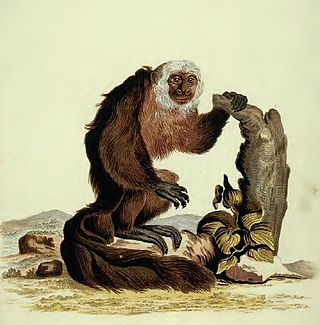
Wilson's snipe is a small, stocky shorebird. The genus name gallinago is New Latin for a woodcock or snipe from Latin gallina, "hen" and the suffix -ago, "resembling". The specific delicata is Latin for "dainty".

The marsh wren is a small North American songbird of the wren family. It is sometimes called the long-billed marsh wren to distinguish it from the sedge wren, also known as the short-billed marsh wren.

The marsh mongoose, also known as the water mongoose or the vansire, is a medium-sized mongoose native to sub-Saharan Africa that inhabits foremost freshwater wetlands. It has been listed as Least Concern on the IUCN Red List since 2008.

The Rio Tapajós saki or Gray's bald-faced saki is a species of saki monkey, a type of New World monkey, from South America. It is found in parts of western Brazil, southeastern Colombia, southeastern Peru and possibly northern Bolivia.

The equatorial saki, also called the red-bearded saki, is a species of saki monkey, a type of New World monkey. It is found in northeastern Peru and Ecuador.

Ridgway's rail is a near-threatened species of bird. It is found principally in California's San Francisco Bay to southern Baja California. A member of the rail family, Rallidae, it is a chicken-sized bird that rarely flies.

The small red brocket is a small species of deer in the family Cervidae. It is endemic to Atlantic Forest in Paraná, Santa Catarina and São Paulo in southeastern Brazil. This species, which only was scientifically described in 1996, is threatened by habitat loss. Though its size and structure most resemble that of the pygmy brocket, its coloration is very similar to that of the red brocket. It resembles hybrids between these two species even more closely, but differs from both, and their hybrids, in karyotype.
Aglaodiaptomus is a genus of copepods in the family Diaptomidae. They are often bright red or blue due to carotenoid pigments.
Boeckella is a genus of copepods in the family Centropagidae.
Hesperodiaptomus is a genus of copepods in the family Diaptomidae, containing 18 species. Two species – Hesperodiaptomus augustaensis and Hesperodiaptomus californiensis – are endemic to the United States and listed as vulnerable species on the IUCN Red List.
Mastigodiaptomus is a genus of Neotropical copepods in the family Diaptomidae. Two of the eight species in the genus are listed as Data Deficient (DD) on the IUCN Red List, and one is listed as a vulnerable species (VU):
Onychodiaptomus louisianensis is a species of calanoid copepod in the family Diaptomidae.
Skistodiaptomus is a genus of freshwater copepods in the family Diaptomidae, found across North America. The genus contains eight species, three of which are endemic to the United States and are listed on the IUCN Red List as vulnerable species (VU) or Data Deficient (DD).

The wildlife of Pakistan comprises a diverse flora and fauna in a wide range of habitats from sea level to high elevation areas in the mountains, including 195 mammal, 668 bird species and more than 5000 species of Invertebrates. This diverse composition of the country's fauna is associated with its location in the transitional zone between two major zoogeographical regions, the Palearctic, and the Oriental. The northern regions of Pakistan, which include Khyber Pakhtunkhwa and Gilgit Baltistan include portions of two biodiversity hotspot, Mountains of Central Asia and Himalayas.

The Red River waterdog, also called Louisiana waterdog, is a species of aquatic salamander in the family Proteidae.

Yucca flaccida, commonly called Adam's needle or weak-leaf yucca, is a species of flowering plant in the asparagus family (Asparagaceae). It is native to south-central and southeastern North America, from the lower Great Plains eastward to the Atlantic seaboard in Virginia, south through Florida and the Gulf states. Its natural habitat is in sandy open woodlands and fields. It is not considered to be threatened by the IUCN.









